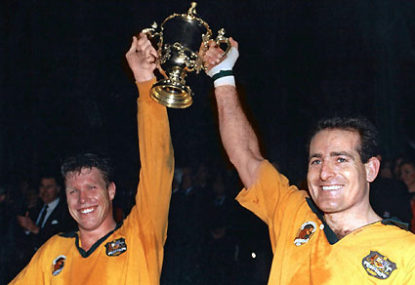A lot of Roarers make the point about how much bigger, faster, and stronger the players of today are. And I agree with them. But my concerns lie more around how the basic skills have been neglected in the process.
Back when I was playing for the Wallabies, we’d usually convene on a Wednesday afternoon before a Test match on the Saturday, play on Saturday, and then play club rugby on the Sunday.
Our focus in the limited time we had together was around building communication and teamwork, ball work, practising basic skills, and doing the simple things right.
And one important thing back then was that coaches were not allowed on the field at halftime of matches.
We had a very strong club competition that we all played in when not on international duty. I strongly believe Australia’s success internationally was a direct result of the influence of the club system.
The club scene was very important because it allowed us to develop our games, our skills, and our teamwork week after week in a competitive but not as pressured environment.
In this environment, we were able to practice moves and try things without fear of being criticised for not following the ‘structure’.
If you did things that worked there, you’d take these new skills to State rugby and test them out. If they still worked, you knew you were onto something and you’d generally give them a go for the Wallabies.
This is how we became such a dangerous backline and dominated internationally with two Rugby World Cup wins.
This environment encouraged creative and confident players who went looking for ways to attack the opposition line, rather than wait for those opportunities to present themselves.
The All Blacks were still THE team to beat (even then), turning out consistently good teams with plenty of power. This strength could also be attributed to the influence of the NGH, which was, and still is, an intricate and well supported part of New Zealand’s rugby heritage and consistent success.
The most difficult opponent I came up against in my career was All Black John Kirwan, who combined speed with size. Kirwan was very dominant on the field and he formed a tight partnership with halfback David Kirk. Yes, back then, wingers and halves actually had combinations.
Nick Farr jones and I had the same. Of my 64 tries, Nick contributed to about 46 of them!
The French sides of that era were also wonderful to watch, with their carefree attitude and free flowing attack. The great Serge Blanco was another tough opponent for me. He was very quick and deceptive and had great vision.
Without the sheer size of the players of today, backs of my era had to rely on skill and speed to break the line. As a result, rugby in general was more entertaining to watch.
Yes, the style has changed. But why? Rugby league – that’s my opinion.
As a winger, I would always try and get involved, rather than hug the sideline and watch the action unfold. I was fortunate that I could read a game well and I developed good combinations with Nick Farr-Jones and Michael Lynagh.
These days, when the wingers come looking for the ball, it’s only when the chosen move allows his involvement. Natural instinct has all but been forgotten.
They need to ask themselves: why are they doing the move infield? What are they trying to create? Don’t just do it for the sake of it.
We had something like 65 different backline movements that we could call on at any time. And there were no video sessions. We learned everything on the training field, or in club rugby.
Or by just trying them.
Then we would react to what was in front of us, unlike the players of today who are all so structured and robotic.
No, I’m not lost in a time warp. I know things are different today. I coach in the modern era, and I can see first hand how the skills are neglected.
I watch a lot of games and see so much of the game revolving around the forwards hitting up their opponents. It’s exhausting and it’s boring.
It frustrates me that they don’t vary their approach and surprise their opponents by moving the ball into space. They would easily break the first line doing this and create more space to move the ball around.
So am I living in a time warp for wanting to see a return to the days when rugby was real entertainment and tries were the biggest part of why people came to watch?
I bet if you took a vote on what is the most exciting part of a rugby game, we would all agree: it’s when a team is unpredictable and a move results in a try.
That’s all I ask for.





























































































